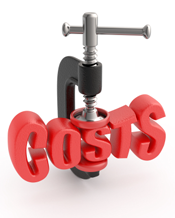Home Restaurant Free Restaurant Business Strategy Questionnaire 4.26 CPI All Items versus Industry Relevant CPI Analysis Questionnaire
4.26 CPI All Items versus Industry Relevant CPI Analysis Questionnaire
 What is the benefit of having a Consumer Price Index (CPI) analysis in a business plan for a Full Service Restaurant?
What is the benefit of having a Consumer Price Index (CPI) analysis in a business plan for a Full Service Restaurant?
The Consumer Price Index (CPI) analysis is a key part of any business plan and we don't think that estimation of costs is complete without taking into consideration this analysis. In this analysis we compare the cost of the Consumer Price Index of the local metropolitan area in which the business is located, to the Consumer Price Index of that particular industry segment that most closely matches the business for which the business plan is being written. Thus if we were writing a business plan for a business in the services sector like accounting, tax preparation, legal advice etc, located in the New York Metro area, we would compare the CPI total for all goods and services in the NY Metropolitan area to the CPI for Cost of Services in the NY Metropolitan area.
The Consumer Price Index is the most commonly used statistic by business owners to determine a host of business decisions including how much raise to give to their employees and which area to locate their business in and so on. The CPI is currently one of the best free government data sources that is available and we recommend that all business owners like Jack Gordon keep a sharp eye on the annual increases in CPI that will most certainly be indicative of an increase in the cost of doing business locally.
How dramatic can the differences in CPI be in different parts of the country from say White Plains, New York?
Quite a bit. The reason is very simple - the prices for all the items that go into the CPI are different in various parts of the country and these prices can differ substantially. Another items of note is that while the CPI may indicate the official government numbers that give us a good read on the increase in prices in any given metropolitan statistical area (MSA), the reality is that the on the ground the prices could be even higher. For example take the NY metropolitan area where the official annual CPI may show a 5% increase in prices, but in actuality for small businesses, there may actually be a 7% to 8% increase in rent - as they say - all real estate is local.
As a general rule the CPI in metropolitan areas tends to be much higher than in suburban areas and two of the main reasons that contribute to this are the increased demand for real estate that drives rents higher along with the fact that all the foods and perishables that a city needs to survive have to be brought in by truck and thus is at quite a distance from the where the products are actually grown - foods, vegetables etc are a classic example - a tomato in New York City will cost you a lot more than a tomato 100 miles north in Duchess County, New York for the simple reason that the tomato has to travel very little to get from the farm in Duchess County to the retailer who will in turn sell it to the general public.
What if there is no industry specific CPI data for the business we are in? What should we do then?
It is rare not to find an industry segment in the CPI data series that may not come close to the industry segment that a small business like A Touch of Tuscany belongs to. In the event you are not able to get a comparative CPI data series, we recommend that you just present the CPI for the corresponding MSA so that the reader of the plan will know that you have made some attempt at understanding the nature of price appreciation in your business planning.
The CPI for my industry segment is showing a much higher increase than the CPI for all goods and services - what do I make of that?The very purpose of conducting this CPI analysis is to see the level of increase in both the CPI for all goods and services for the metropolitan area, and the CPI for the industry segment in that particular metropolitan area. Our analysis requires the dumping of the data set in our templates and then template goes to work and shows the final output which plots both the CPI lines on a single graph. The difference between the slope of the two lines indicates the rate of change between the two CPI indices.
Thus in the event the rate of change for industry specific CPI is more than that of the regular CPI it would mean that the costs in your industry segment are moving up at a faster clip than the rest of the items in the general CPI basket which contains all the goods and services including the one offered by your specific industry. This is quite significant, if you are a business owner like Jack Gordon and are looking to set competitive pay increases. If you were to set the increase at the regular CPI level of inflation, you may lose your staff to the competition who may be setting pay increases based on the industry specific CPI as opposed to the regular CPI. As a general rule, most pay increases tend to be anchored to the national CPI but we all know that in reality that national number does not mean much in metropolitan areas where costs can rise at a much higher rate than those nationally.
How many years should we look at when conducting this analysis for the CPI for a business like A Touch of Tuscany?
We recommend that data be obtained for monthly index values going back at least a 10 years to show the change in prices for the CPI of all items as well as the industry specific CPI. The reason we need to take a long view when looking at prices, is that in the short term, prices could be subject to wild fluctuations and thus you may even have a situation where during recessions or economic slow downs, prices actually stall or retreat. It is to remove the inconsistencies that any short term fluctuation may show, and to do that we look at data over a decade.
What does a dip in the CPI indices indicate? Is a drop in prices a good thing for small businesses?
A drop in the CPI index indicates of course the prices for the goods and sevices that form the index are dropping. While on the surface the fall in prices may be a good thing for a small business is it NOT. A decline in prices of goods and services indicates that businesses are not able have the kind of pricing power they used to and they are having to cut prices to make sales. This in turn means that their profitability is going to be hurt and they will start making changes in their businesses like reducing overhead and letting go of staff - this of course only means that the folks that have been let go and other small businesses that cater to our business will scale down their operations ultimately resulting in a national or regional slowdown in economic activity and vitality - a recession. Thus it is always preferable to have a slight upward bias in the CPI indices that indicates a slight upward pricing power for small businesses.
Is a sharp increase in the CPI indices a good thing for small businesses?
No. A sharp increase in the CPI indices indicates that prices are moving up quickly for the goods and services that compose the index and that is not a good thing since it indicates that businesses are raising prices and in turn risk pricing themselves out of the reach of the consumer. Very close attention is paid the rise in CPI by all kinds of small businesses like the food and beverage industry. If the cost of gasoline starts spiraling upwards, it can likewise affect the price of milk and cheese which in turn will affect the price you can charge as a franchisee of a large fast food restaurant chain. A sharp increases in the CPI for your business / industry segment indicates that you and business owners like yourself are having to charge the consumers higher prices for your goods and services and there is always a risk that consumers may backlash and start looking for alternatives instead. Thus if the prices at local restaurants are moving up rapidly, folks may just stay away from restaurants and look for alternatives at home instead.
As a small business owner, a sharp increase in the CPI for your industry segment may also present an opportunity to you. Lets say that your competition is charging $5 for a burger for $15 for a full service car wash because they have a much higher cost structure than yours - you may be able to keep your prices the same and take away market share from the competition by choosing not to increase your prices or increasing them at a slower rate than the competition. This will no doubt affect your profit margin but in the end if it drives out the competition and leaves you as the only game in town - it may not be a bad strategy - Wall Mart and other category killers use their massive economies of scale to achieve precisely this end.
Quick Links:
- Go to the Corresponding Template section for this industry.
- Go to the Corresponding Business Plan section for this industry.
Small Business Owner Resource Center

Articles on the Small Business Financing Sources, the Small Business Loan Basics, small business loans Checklist and SBA Loans are incredible sources of knowledge for the small business owner.

Credit Report and Credit Score Analysis, how to Read a Personal Credit Report and all about Business Credit cover the intricacies of credit and are required reading for everybody.

The Foundation Grant Directory is a free listing of sources for grants by state. Why not look if there is some free money out there for your business. Hey - you never know!

The Business Loan Application covers every item you will need in your loan package and tells you how to get approved for business loans.

Fire your loan broker and use our Free Business Loans Bank / Lender Directory to find every bank in the country lending to small businesses.

If you are looking to start a business - look no further. Check out the Free Incorporation Guide discussion and the State Incorporation Resource Directory.




